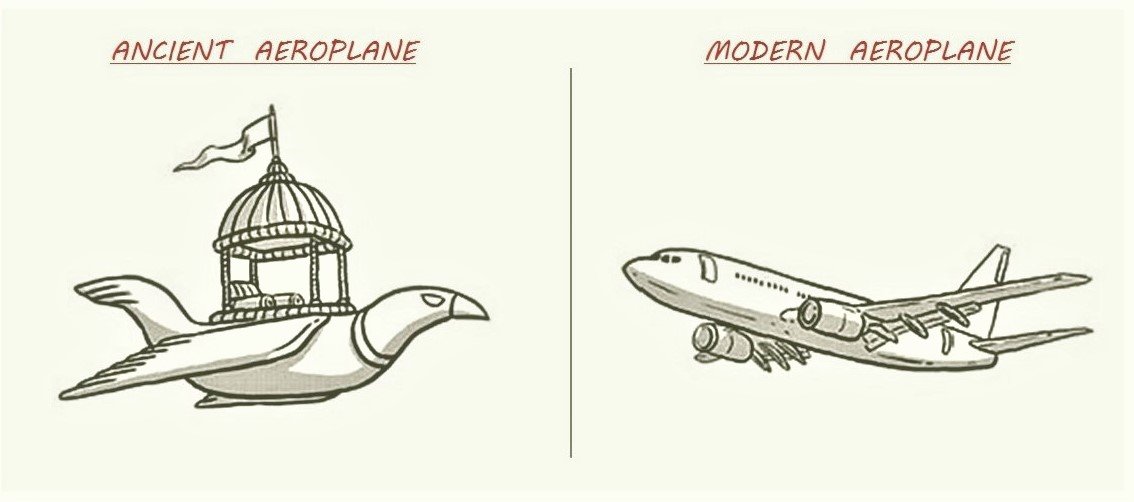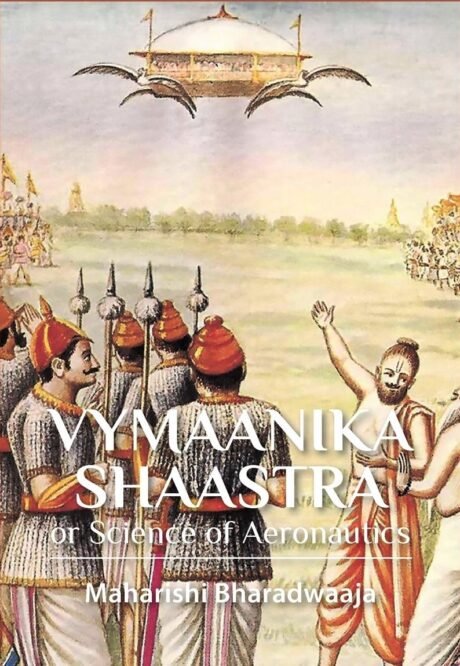
Synopsis: This article has many references of aircraft in ancient Sanskrit scriptures. It also mentions few details on these flying devices by Sage Bhāradvāja where he talks about several qualities and features like military aircrafts, invisibility, maneuverability, codes of conduct etc.
We are living in the Age of Science where lots of inventions and researches are being done everyday. The invention of aeroplane has a special significance amongst all these inventions. In the modern times, 17th December 1903 is marked as the historic day when the concept of flying by humans was presented to the world by the Wright Brothers.
In this article, we will debunk this myth, by presenting literary evidences available in the ancient Indian scriptures which will prove that aeroplanes (flying devices) were frequently used in the ancient times.
Reference of Aeroplanes in Ancient Sanskrit Scriptures
1. Concept of making an aircraft for convenient arrival and departure by flying like a bird in the sky was shared in Ṛgveda 4.26.15.6
ṛṛjīpī śyeno dadamāno aṃśu parāvataḥ śakuto mandraṃ madam/
soma bharaddādvahāṇo devāvāndino amusmāduttarādāya//
Ṛgveda 4.26.15.6
2. Description of a flying machine without any pilot is found in Ṛgveda 1.30.18
samānayojano hi vā ratho dastrāvamartyaḥ/
samudre aśvineyate//
Ṛgveda 1.30.18
3. Reference of Puṣpaka Vimaan (aircraft) is available in Rāmāyana by Vālmikī.
rākṣasyastastathaityutvā jagmurvai patrapuṣpakam/
sītāmāropayāmāsurvimānaṃ puṣpakaṃ tadā// –
Vaidika vānmaya meṃ vijṇāna, samullāsa- 5, p.121
4. Reference of “Tripurī” made by Mayāsura is available in Karṇaparva of Mahābhārata which is described as a vehicle which was capable of operating on land, water and air.
asmabhyaṃ tvaṃ varaṃ deva samprayaccha pitāmaha/
vastumicchāma nagaraṃ kṛtvā kāmagamaṃ śubham/
sarvakāma samṛddhāthamavadhyaṃ devadānavaiḥ/
vadhyeta tripuraṃ deva prasanne tvayi sādaram//
Mahābhārata Karṇaparva 33.11
Without any archaeological evidence, these references might stand the risk of being considered fanciful stories stemming from human imagination. Fortunately, a chapter named Vimāna-prakaraṇa in a text Yantra-sarvasva is available, which proves otherwise. The text was composed by the great sage Bharadvāja.
5. In this context, Bodhānanda, the commentator of the chapter Vaimānika-prakaraṇa says, ” after churning the ocean of knowledge in Vedas, sage Bhāradvāja composed Yantrasarvasvam”
nirmathya tadvedāmbudhiṃ bharadvājo mahāmuniḥ/
navanītaṃ samuddhṛtya yantrasarvasvarūpakam//
vaimānikādhikaraṇamutaṃ bhagavatā svayam//
Bhā. me. vijñā. ujja. par. Ch.7 p.49
According to his commentary, the 40th part of that composition was about aircrafts with 8 chapters and 500 verses in it. This book was available in the State General Library of Baroda in 1950 ADE.
List of References in Vimāna-prakaraṇa
A list of other scientific reference books are available in the second verse of Vimāna-prakaraṇa as – Vaidika vānmaya meṃ vijṇāna, samullāsa- 5, p.118
| Name of the Text | Name of the Author | Subject of the Text |
| Śaktisūtra | Agastya | Energy and electricity |
| Saudāminīkalā | Iśvara | Lightning |
| Ākāśaśāstra | Anonymous | Spaceology |
| Vāyutattvaprakaraṇa | Śākaṭāyana | Aeronautics |
| Baiśvānaratantra | Anonymous | Cosmic heat |
| Dhūmaprakaraṇa | Nārada | Topic of gases |
| * | * | * |
| Vimānacandrikā | Nārāyaṇa | Aeroplane |
| Vyomayānatantra | Śaunaka | Aeroplane |
| Kalpa | Garga | Aeroplane |
| yānavindu | Vācaspati | Aeroplane |
| Vyomaprakāśa | Dhundinātha | Aeroplane |
Henceforth, it can be concluded from the above description that new scientific researches and inventions in ancient India were at it’s peak during ancient period.
- Related Articles:
- Ancient Remedies for Anxiety and Depression
- Aeronautics in Ancient India (PART 1)
- Aeronautics in Ancient India (PART 2)
- Battery and Electricity in Ancient Times
- Knowledge of Mathematical Value of Π (PI)
- Knowledge Of Gravity in 6 BCE
- Reproductive Endocrinology during Mahabharata
- Sound Energy and Introduction to Mantras
- Suśruta: The Father of Surgery and Plastic Surgery
- Scientific Analysis of the birth of Kauravas
- Surgery in Ancient India: Introduction (Part One)
- Surgery in Ancient India: Types of Surgery (Part Two)
Mention of Few Details by Sage Bhāradvāja

The great sage Bhāradvāja has also provided us with elaborate description on several technical terms and concepts related to the aircraft. We can find detailed description of the engine, it’s structure, tail and wings of the aircraft, propeller, the up and down drafts, parts of the plane, metals used for the construction etc. He even covered topics like the eligibility and training of a pilot, airways, responsibilities of the ground staff, official dress code, maintenance and much more.
Kṛtaka Rahasya
Knowledge of the construction of an Aircraft is the third most important piece of information for a pilot. According to this study, a pilot should be able to build an aircraft with appropriate metals by following the prescriptions in the composition by Viśvakarmā, Manu and the great demon Maya.
Gurha Rahasya
In this fifth quality prescribed for the pilots, it learned the procedure of hiding the aircraft, so as to make it invisible to others.
Aparokṣa Rahasya
This is the ninth quality by which the pilot studied about the use of electricity called rohinī. This equipped it to see the physical objects that would come in front of the aircraft.
Saṅkocā
The tenth important quality of a pilot was the ability to reduce the size of the aircraft while it was still in the air, as and when required.
Vistṛtā
This eleventh quality taught the pilots how to increase the size of the aircraft during a flight, when it was in the air. Example: puṣpaka
These skills were very important to learn, so that they could be applied in times of need.
Sarpāgaman Rahasya
This is the twenty second quality mentioned in the book. This was the ability of the pilot to fly the aircraft in a curve and zig-zag shape like that of a snake.
Paraśabdagrāhaka Rahasya
This is the twenty fifth quality which is elaborated in the composition Saudāminīkalā. As per the description, with the help of audio devices in the plane, the pilot could hear the people in a different aircraft.
Rūpākarṣaṇa Rahasya
This study made it possible for the pilot to see everything inside the aircraft.
Digpradarśana Rahasya
With use of the machine Diśāsampatti, it was possible to track down the navigation and speed of the other aircrafts.
Stabdhaka Rahasya
There is also mention of a device or missile, which when shot at the other aircraft, could make the passengers of that aircraft unconscious. The gas apasmāra is said to be used with the use of a machine called stambhana for this purpose.
Karṣaṇa Rahasya
This is the thirty second quality according to which the enemy aircraft could be destroyed by the pilot with the use of a machine named Śakti.
The composition of sage Bharadvāja can be a very helpful guide to a scientist in researching how to build an extraordinary aircraft well equipped with all the modern facilities and technologies. This will hopefully help us decode and better understand the technologies available in ancient times and assist us in upgrading and further refining the available technology in modern times.
Contributor : Dr Poornima Singh Rana
English Translator : Joy Dev

